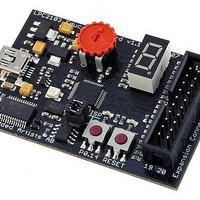EA-EDU-009 Embedded Artists, EA-EDU-009 Datasheet - Page 20

EA-EDU-009
Manufacturer Part Number
EA-EDU-009
Description
MCU, MPU & DSP Development Tools LPC2103 EDUCATION BRD
Manufacturer
Embedded Artists
Specifications of EA-EDU-009
Processor To Be Evaluated
LPC2103
Data Bus Width
16 bit, 32 bit
Interface Type
I2C, SPI, UART
Core
ARM7TDMI-S
Dimensions
68 mm x 42 mm
Maximum Operating Temperature
+ 85 C
Operating Supply Voltage
3.3 V
Lead Free Status / RoHS Status
Lead free / RoHS Compliant
NXP Semiconductors
LPC2101_02_03_4
Product data sheet
6.17.8 APB
6.18 Emulation and debugging
In Idle mode, execution of instructions is suspended until either a reset or interrupt occurs.
Peripheral functions continue operation during Idle mode and may generate interrupts to
cause the processor to resume execution. Idle mode eliminates power used by the
processor itself, memory systems and related controllers, and internal buses.
In Power-down mode, the oscillator is shut down and the chip receives no internal clocks.
The processor state and registers, peripheral registers, and internal SRAM values are
preserved throughout Power-down mode and the logic levels of chip output pins remain
static. The Power-down mode can be terminated and normal operation resumed by either
a reset or certain specific interrupts that are able to function without clocks. Since all
dynamic operation of the chip is suspended, Power-down mode reduces chip power
consumption to nearly zero.
Selecting an external 32 kHz clock instead of the PCLK as a clock-source for the on-chip
RTC will enable the microcontroller to have the RTC active during Power-down mode.
Power-down current is increased with RTC active. However, it is significantly lower than in
Idle mode.
In Deep-power down mode all power is removed from the internal chip logic except for the
RTC module, the I/O ports, the SRAM, and the 32 kHz external oscillator. For additional
power savings, SRAM and the 32 kHz oscillator can be powered down individually. The
Deep power-down mode produces the lowest possible power consumption without
actually removing power from the entire chip. In Deep power-down mode, the contents of
registers and memory are not preserved except for SRAM, if selected, and three general
purpose registers. Therefore, to resume operations, a full chip reset process is required.
A power selector module switches the RTC power supply from VBAT to V
the core voltage is present on pin V
A power control for peripherals feature allows individual peripherals to be turned off if they
are not needed in the application, resulting in additional power savings during Active and
Idle mode.
The APB divider determines the relationship between the processor clock (CCLK) and the
clock used by peripheral devices (PCLK). The APB divider serves two purposes. The first
is to provide peripherals with the desired PCLK via APB so that they can operate at the
speed chosen for the ARM processor. In order to achieve this, the APB may be slowed
down to
power-up (and its timing cannot be altered if it does not work since the APB divider control
registers reside on the APB), the default condition at reset is for the APB to run at
processor clock rate. The second purpose of the APB divider is to allow power savings
when an application does not require any peripherals to run at the full processor rate.
Because the APB divider is connected to the PLL output, the PLL remains active (if it was
running) during Idle mode.
The LPC2101/02/03 support emulation and debugging via a JTAG serial port.
1
2
to
1
4
of the processor clock rate. Because the APB must work properly at
Rev. 04 — 2 June 2009
DD(1V8)
to conserve battery power.
Single-chip 16-bit/32-bit microcontrollers
LPC2101/02/03
© NXP B.V. 2009. All rights reserved.
DD(1V8)
whenever
1
4
20 of 37
of the



















